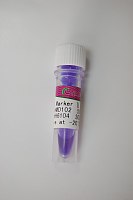Site-Directed Mutagenesis of Double-Stranded Plasmids, Domain Substitution, and Marker Rescue by Comutagenesis of Restriction Enzyme Sites
互联网
602
Oligonucleotide-directed mutagenesis can be used to introduce specific alterations in cloned DNA, including base-pair substitutions, insertions and deletions. It is an important procedure in studies of gene expression and protein structure/function relationships. A variety of protocols have been developed to mutate specific bases in plasmid DNA, all of which involve annealing oligonucleotide primers with specific mutations to target sequences (1 –4 ; reviewed in 5 ). Primer-directed DNA synthesis creates a DNA strand containing the desired mutation that may segregate from the wild-type template strand during DNA replication following transformation into an E. coli host. Although the theoretical yield of mutant products is 50%, the actual yield is usually much lower, necessitating strategies for enriching for products derived from the mutant strand. Two successful strategies for mutant enrichment involved the in vivo degradation of wild-type strands containing uracil bases in place of thymidine (3 ,6 ; see Chapter 55 ) and selection of mutant strands carrying a second mutation that creates a functional selectable marker, such as the β-lactamase gene (7 ). Systems that involve secondary selectable mutations depend on coupling of two primers during DNA synthesis, and are improved by the use of T4 DNA polymerase rather than the Klenow fragment of E. coli DNA polymerase, since the T4 enzyme does not displace the mutagenic primers (8 ,9 ).









